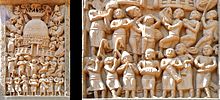
Back Buddhistische Musik German Música budista Spanish Musique bouddhique French Buddhista zene Hungarian 仏教音楽 Japanese 불교 음악 Korean 佛教音樂 Chinese


Buddhist music is music (Sanskrit: vàdita, saṅgīta) created for or inspired by Buddhism and includes numerous ritual and non-ritual musical forms.[2] As a Buddhist art form, music has been used by Buddhists since the time of early Buddhism, as attested by artistic depictions in Indian sites like Sanchi. While certain early Buddhist sources contain negative attitudes to music, Mahayana sources tend to be much more positive to music, seeing it as a suitable offering to the Buddhas and as a skillful means to bring sentient beings to Buddhism.[3][4]
Buddhist music retains a prominent place in many Buddhist traditions, and is usually used for ceremonial and devotional purposes.[5] Buddhist music and chanting is often part of Buddhist rituals and festivals in which they may be seen as offerings to the Buddha.[6]
Most Buddhist music includes chanting or singing, accompanied by instruments.[7][2] The chanting is often of traditional texts which include: sutras, mantras, dharani, parittas, or verse compositions (such as gathas, stotras, and caryagitis). Buddhist instrumental music does exist, though it is less commonly heard in temples.[7]
Examples of Buddhist musical traditions include the Newari Buddhist Gunlā Bājan, Tibetan Buddhist music, Japanese Buddhist Shōmyō, modern Indian Buddhist bhajans, and Cambodian Smot chanting. As there are many different traditions of Buddhist music and chanting, the musical instruments used vary widely, from solely relying on the human voice, to many types of classic instruments used in Asian music (such as the ancient Indian veena) as well as modern instruments (keyboards, guitars, etc).
In the modern academy, the study of Buddhist music, sometimes known as Buddhist musicology, has become its own field of academic research.[8]
- ^ "Musicians generally described as "Greeks" from the eastern gateway at Sanchi" in Stoneman, Richard (2019). The Greek Experience of India: From Alexander to the Indo-Greeks. Princeton University Press. pp. 441–444, Fig. 15.6. ISBN 9780691185385.
- ^ a b Mross, Michaela (2022). Memory, Music, Manuscripts: The Ritual Dynamics of Kōshiki in Japanese Sōtō Zen, p. 7. Michaela Mross University of Hawaii Press.
- ^ Cite error: The named reference
:6was invoked but never defined (see the help page). - ^ Mabbett, Ian W. (1993-1994). 'Buddhism and Music'. Asian Music, 25(1-2), 9–28. Doi:10.2307/834188
- ^ Mabbett, Ian W. “Buddhism and Music.” Asian Music, vol. 25, no. 1/2, 1993, pp. 9–28. JSTOR, https://doi.org/10.2307/834188. Accessed 18 Dec. 2023.
- ^ Szczepanski, Beth (2021). "Buddhism and Music". Oxford Bibliographies. Retrieved 2023-12-18.
- ^ a b Van Khê, Trân. “Buddhist Music in Eastern Asia.” The World of Music, vol. 26, no. 3, 1984, pp. 22–32. JSTOR, http://www.jstor.org/stable/43561005. Accessed 18 Dec. 2023.
- ^ Greene, Paul D., et al. “Buddhism and the Musical Cultures of Asia: A Critical Literature Survey.” The World of Music, vol. 44, no. 2, 2002, pp. 135–75. JSTOR, http://www.jstor.org/stable/41699430. Accessed 20 Dec. 2023.